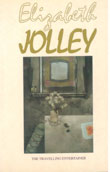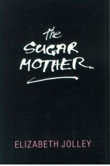

Courtesy Fremantle Press
The Shape of the Bibliography
Though entries in Elizabeth Jolley: A Bibliography--1965-2007 are
arranged chronologically to enable a reading focussed on one career in
writing and the institutional structures that enabled her career, they
are also arranged generically in four Parts, each with subsections, so
that readers more easily can explore particular topics—say, reviews
written by Jolley or reviews written about her work, or perhaps adaptations
of her work or dissertations written on it, and so on. Moreover, the presentation
of the Bibliography as a searchable data base enables readers to
search for individually defined topics, commentators and/or themes.
A Note on the Arrangement of the Bibliography
The subsection of Part 1, titled Novels and Collections of Short Stories and Essays, records the publication history of the editions of each book, including any translations. Translations are listed last in each reference, even when an English-language edition occurred later than the first translation. Publishers' imprints are shown separately (for example, Viking-Penguin and Penguin editions are shown as separate publications, not reprints) according to publication information. Complex publisher agreements sometimes result in a lack of clarity regarding the primary place of publication, and so the several places of publication for each edition are shown (Fremantle Arts Centre Press editions appeared simultaneously in New Zealand). Reprints are not represented, even though they often have different covers, formats, or added front-page information about the author or novel; generally the pagination in these reprints is the same as in the original edition.
The subsection in Part 1 titled Short Stories Separately Published
shows all stories that found publication in journals, magazines, anthologies
and so on (including translations), and includes extracts from the novels
published separately either as a titled short story or as a piece from
a work in progress. In Jolley's writing there often is a close correspondence
between a separately published short story (as well as an extract) and
a novel, and the Bibliography shows such correspondence by placing
the page numbers from the relevant novel in square brackets. For example,
the link between the short story “The Talking Bricks” (1963)
and Mr Scobie's Riddle (1983) is shown as:
“The Talking Bricks.” [SR 10-11, 29, 31-34, 92-93, 104-105] Summer's Tales 2. Ed. Kylie Tennant. Melbourne: Macmillan, 1965. 158-68.
In cases where different publishers' editions of the same novel involve a variation in pagination (as with Penguin and Fremantle Arts Centre Press editions of The Sugar Mother) pagination for showing such linkage is taken from the first published edition.
The three subsections in Part 1 titled Essays, Occasional Pieces,
and Ephemera are defined by the following criteria:
- Essays are self-contained critical or reflective prose
pieces.
- Occasional Pieces comprise such items such as
letters to newspapers, tributes, short non-generic prose pieces, graduation
addresses, and the like. These pieces generally are not published in
any of Jolley's collections of essays and, where they have been,
the entry includes that information.
- The category of Ephemera includes pieces Jolley contributed to magazines and newspapers, usually at the request of an editor compiling responses from a range of people. Items range from recipes, to recommendations for reading, to views on topical issues, and the like.
The diversity and extent of these items, taken together with the numbers of book reviews Jolley wrote, are a measure of the importance of her voice in Australian cultural conversations across three decades from the mid seventies onwards.
The subsections of Part 2 of the Bibliography distinguish between two types of publications related to Jolley's life and work—Interviews (print, audio and filmed) and Profiles.
- Interviews are usually in-depth and relatively lengthy.
- Profiles are more journalistic in style and purpose, and generally consist of feature articles (of varying length) which focus on Jolley's life experiences and writing achievements; they often contain direct statements by Jolley.
These entries are complemented by the sub-section in Part 1, “Works by Elizabeth Jolley,” titled Reminiscence/Autobiography.
Part 3 of the Bibliography is arranged in four subsections—Film/Video Adaptations, Stage Adaptations, Audiobooks, and Braille Adaptations—with each section followed by a listing of reviews and news articles related to adaptations. With regard to entries for Audiobooks, the Bibliography gives information as to the format of audio (or “talking”) books: audiotape and CD formats can be played on a generally available machine; an audiocassette generally has four tracks and requires specialised playback equipment (talking book machines).
Part 4 of the Bibliography, “Works on Elizabeth Jolley,” more than doubles the entries of the first three Parts and records the remarkable range of the response elicited by her writing. That response starts with: the first book review she received (for Five Acre Virgin and Other Stories) by Jean Bedford (1977); the first article about her by WAIT colleague Margaret Maslen (1977); three significant early appreciations of her work by Thomas Shapcott (1980), Veronica Bradey (1982) and Helen Garner (1983); the first of several dissertations on her work by Jing Zhou (Griffith University, 1989); and the first book-length study of her work, a collection of essays edited by Delys Bird and Brenda Walker (1991). Similarly, the response to her work is recorded in the plethora of news articles and brief notices that reflect the prominence of the career in writing that Jolley imagined during her writing youth in England and Scotland, struggled for during the sixties and seventies in Australia, and enjoyed from the early eighties onward until her death on 13 February 2007.

Courtesy Fremantle Press